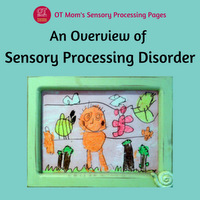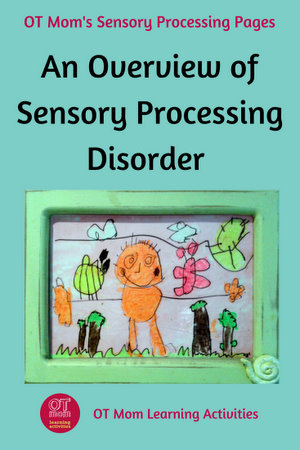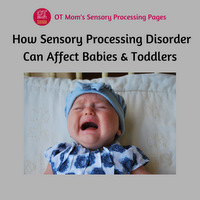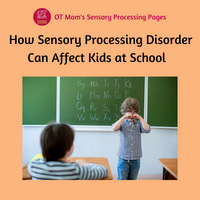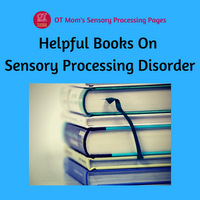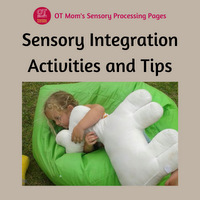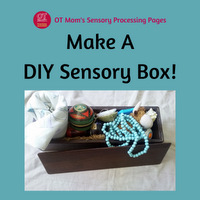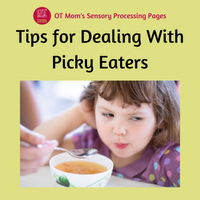- Home
- Overview of Sensory Processing Disorder
Sensory Processing Disorder
Sensory Processing Disorder (SPD) is a term that is becoming more and more familiar to teachers and parents. However, many people still don't fully understand what it is about or how it can affect day-to day life at home and at school.
This page gives an overview of sensory processing, with some helpful links to more in-depth information and some helpful SPD books.
Click on the quick links below to jump to the sections you want to read.
What is Sensory Processing?
Sensory Processing is a normal process that takes place in all of our brains. Without it, we would be unable to function effectively!
This is how it works under normal circumstances:
Sensory information is sent to the brain from:
- The eyes (visual information)
- The ears (auditory information)
- The nose and tongue (olfactory and taste information)
- The skin (tactile information)
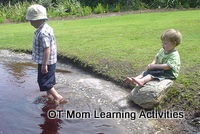 Taking in sensory information outdoors
Taking in sensory information outdoorsAdditional vital sensory information is obtained from:
- The semi circular canals in the inner ears – this is vestibular information which tells the brain if and how the body is moving
- The muscles and joints – this is proprioceptive information which tells the brain about the position of the various body parts
Normal sensory processing occurs when the brain:
- receives information from all the senses of the body,
- processes (or integrates) that information,
- decides how the body should respond,
- and then sends the message for the body to respond appropriately.
When the brain does not adequately process the information it receives from the senses, then the child may experience a disorder of sensory processing - also known as sensory integration disorder.
Sub-Types of SPD
Experts in the field have written numerous excellent books on sensory processing disorder, and the various sub-types that children can present with. I often refer parents to those books for a more in-depth understanding.
But for now, here is a quick overview of the different sub-types - and remember, a child may experience difficulties in more than one area!
1) Sensory Modulation Disorder
Sensory modulation is the ability to regulate, or modulate, the information that the brain is receiving from the senses, so that the amount of stimulation is just right - not too much, and not too little.
A sensory modulation disorder can present in different ways:
-
a child who is over responsive to sensory stimulation, can easily
become overstimulated or overwhelmed by the information coming from from
any or all of the senses.
This is often described as being sensory defensive, with some children being particularly sensitive to touch (tactile defensive) or sound (auditory defensive).
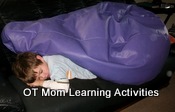 Helping an overwhelmed child calm down
Helping an overwhelmed child calm down- a child who is lethargic and under responsive to the environment, may seem to have an attention deficit, when actually the brain is just not getting the stimulation it needs to engage properly with the lesson/environment. This child may appear to be lethargic and slow to get going, and could be under-responsive to sensory stimulation.
- some children are described as sensory seeking because their poor sensory processing means they excessively seek out sensory stimulation. These kids may be described as “hyper” and "hectic", always crashing, bumping, chewing, pushing, wiggling and jiggling, far in excess of what their peers engage in.
2) Sensory-Based Motor Disorder
In normal sensory processing, the brain receives messages from all the senses of the body and then works with the information to tell the body how to respond to the information.
When the brain does not process information properly, and therefore does not send the right messages to the body, everyday physical (motor) tasks may be affected.
Here are some possible scenarios:
- Poor postural control:
This child may struggle to sit upright at a desk, and may struggle with balance and many gross motor and fine motor tasks.
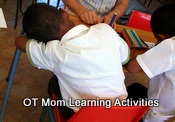 Poor postural control
Poor postural control- Poor bilateral integration skills and poor motor planning skills (dyspraxia):
Some examples of tasks requiring these skills are tying shoelaces, cutting with scissors, riding a bicycle, bouncing a ball and learning how to do new tasks. Children with dyspraxia often struggle to organize themselves and to follow instructions
3) Sensory Discrimination Disorder
Children who have difficulties in this area may struggle to process and understand any or all of the following:
- what they see - this may result in poor visual perception and spatial perception
- what they hear - this may result in auditory perception problems, where the child struggles to listen, to remember verbal instructions and to make sense what is being said
- or what they feel (tactile perception problems) - this may result in a child being clumsy because the brain is not understanding what the hands and body are feeling
For a more indepth look at how these different subtypes of SPD may affect a child's learning, take a look at this page of my site: Sensory Processing Disorder in the Classroom.
Diagnosing Sensory Processing Disorder
Before you rush into labeling your child or yourself, remember that sensory processing is a normal process we all experience, and we can all have good days and bad days. Sleep deprivation, poor nutrition, illness, and stress can all contribute to moments or days of poor sensory processing. Even PMS can make you feel like you are sensory defensive and heading for a meltdown!.
What we are concerned about is a pattern of repeatedly struggling with the same issue over a period of time, to the degree that it affects your child's day to day functioning - eating, dressing, schoolwork, relationships etc.
- Sensory processing/integration disorder is usually diagnosed by an occupational therapist, and occupational therapy
is usually recommended in order to help the child and the parents learn to cope with it.
- Your occupational therapist will use sensory integration
techniques that are designed to stimulate the appropriate sensory system
and prompt the brain to process the information more effectively. Your OT should also help you to identify and implement coping strategies and a sensory diet that will help your child at home and at school.
- If
you suspect your child may have a sensory integration disorder, please
request an appointment with an occupational therapist as soon as
possible!
- It is important to recognize that sensory
integration dysfunction cannot be cured with medication. It is a neurological issue and the underlying processing deficits can be
addressed through intervention with sensory integration techniques.
- I also really recommend that parents and kids read at least one good book on Sensory Processing Disorder to better understand how to cope with daily challenges.
SPD Resources
These are some sensory processing resources that parents, teachers and therapists have found to be helpful over the years.
- Weighted vests#Ad, weighted blankets and weighted lap blankets#Ad
are effective ways to give passive proprioceptive input, and many
children find the deep pressure sensory support to be very helpful and
calming.
- Some kids benefit from chewing gum or eating very crunchy food, while others need to chew on something more durable like special chewy pendants#Ad.
- Tom's Flippy Fidget Chains (#Ad)
are my family's own choice of fidget toys - this brand is the best
quality, and are a great, small toy to keep in your handbag or in your
pocket to haul out when your child needs something to fiddle with.
These are definitely the quietest fidgets, and very effective.
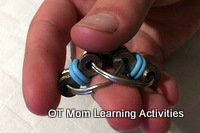 Fiddling with a fidget chain
Fiddling with a fidget chain- It is really helpful to have a good book on sensory processing that you can share with your child's teacher, family members and anyone else who needs to understand your child.
-
Here are some ideas for sensory integration activities and exercises to do at home to support and help kids who struggle, particularly with sensory modulation. This page also contains tips on how to make a sensory corner.
Thanks for reading this page - I hope it was helpful and gave you insight into what sensory processing is, and how some kids can struggle to process sensory information.
Why not sign up for my occasional newsletter to be informed when new articles are posted on my site?
- Home
- Overview of Sensory Processing Disorder
If this page was helpful, please share it with your friends!
Related Sensory Pages and Links
And last, but not least, a thought provoking article by Lemon Lime Adventures: 10 things to never say to a child with Sensory Processing Disorder!
Didn't find what you were looking for? Try a search of my site!
What Other Visitors Have Said
Click below to see contributions from other visitors to this page...
Any Sleeping Tips For Kids With Sensory Modulation Issues?
Any suggestions for helping a 5 year old boy who has mild to moderate sensory modulation issues (hypersensitive to auditory and visual stimuli) with developing …
Classroom Tips for Sensory Kids?
Does anyone have any sensory tips for second graders to make their work and focus easier, aside from balls to sit on or weighted lap mats...any tips or …
Sensory Processing Disorder (long term prognosis)
Will a child that has a processing disorder ever improve to the point that he can be on grade level without a constant struggle? My 10 year old grandson …
Living with Sensory Processing Difficulties
I would just like to share how my son is learning to cope with his sensory processing difficulties!
J is 7 1/2 years and has struggled with sensory …
My son has sensory problems
My 5 year old son has sensory problems. What kind of exercises does my child needs to do when he is 'sensory defensive'? I want to exercise at home with …
